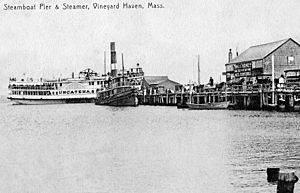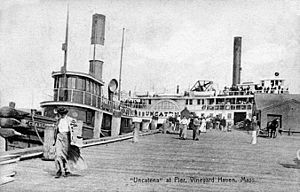Uncatena (steamboat) facts for kids
class="infobox " style="float: right; clear: right; width: 315px; border-spacing: 2px; text-align: left; font-size: 90%;"
|+Uncatena
| colspan="2" style="text-align: center; font-size: 90%; line-height: 1.5em;" | 
|}
The sidewheeler ferry Uncatenaat Union Wharf in Vineyard Haven, MAbefore 1915.
The Uncatena was a special type of boat called a sidewheel steamer. It worked as a ferry boat, carrying people and goods to the island of Martha's Vineyard in the early 1900s.
Contents
- A New Kind of Ship for Martha's Vineyard
- How Fast Was the Uncatena?
- A Poem for the Uncatena
- Who Sailed the Uncatena?
| History | |
|---|---|
| Namesake | Uncatena Island |
| Operator | New Bedford, Martha's Vineyard, and Nantucket Steamboat Co. |
| Launched | 1902 |
| Out of service | 1928 |
| General characteristics | |
| Tonnage | 652 tons |
| Length | 187 ft (57 m) |
| Beam | 31 ft (9.4 m) |
| Speed | 15 knots (28 km/h; 17 mph) |
What Was the Uncatena?
The Uncatena was built in Wilmington, Delaware in 1902. It was named after Uncatena Island, which is one of the Elizabeth Islands. This ship was quite large, weighing 652 tons.
A New Kind of Ship for Martha's Vineyard
The Uncatena started its service right away. It worked for the New Bedford, Martha's Vineyard, and Nantucket Steamboat Co.. This ship was very important because it was the first steamer built with a strong steel hull to serve the island. It was also the first with a propeller.
Instead of a regular propeller, the Uncatena used large paddles on its sides. These paddles were hidden inside the ship's upper structure. You could see the outline of the paddle boxes on the sides of the boat.
How Fast Was the Uncatena?
The Uncatena was 187 feet long and 31 feet wide. It was built with a clever design that made it easier for passengers. On older boats, people had to duck to walk under a part of the ship. But on the Uncatena, the shaft was placed low, so passengers could walk over it easily.
This ship was also very fast for its time. It could travel at a speed of 15 miles per hour. The Uncatena was often faster than other boats in its fleet.
A Poem for the Uncatena
The Uncatena was so special that a famous poet wrote about it. Robert Hillyer, who won a Pulitzer Prize, wrote a poem called "In Memoriam Sidewheeler Uncatena" in 1948. Mr. Hillyer loved Martha's Vineyard. He first visited the island on the Uncatena many years before.
Who Sailed the Uncatena?
Two captains were known for sailing the Uncatena. They were Captain Marshall, who was likely Francis J. Marshall from Edgartown, and Captain Sylvia.
When Did the Uncatena Stop Running?
The Uncatena served the island for 26 years. It was retired from service in 1928.


